Content
Published:
This is an archived release.
7 tables, table 09405, 09406, 09408, 09409, 09416, 09417 and 09421, was released 18.08.2017 with figures for the years 2002-2009 by new Standard for types of offence (Group of offence 2015 and Type of offence 2015).
Fewer young people charged
The police and the Prosecution authority completed the investigation of more than 329 000 offences in 2015. This is 5.8 per cent fewer than the year before. Over the past few years, there has been a large reduction in the number of people charged under the age of 30 years, a trend that continued in 2015.
| 2015 | |
|---|---|
| Offences investigated | 329 164 |
| Offences investigated and solved | 169 088 |
| Charges against persons | 170 713 |
| Persons charged | 80 340 |
| Persons charged in base year included in recidivism statistics | 75 787 |
| Persons charged in base year with recidivism in the following five-year period | 33 705 |
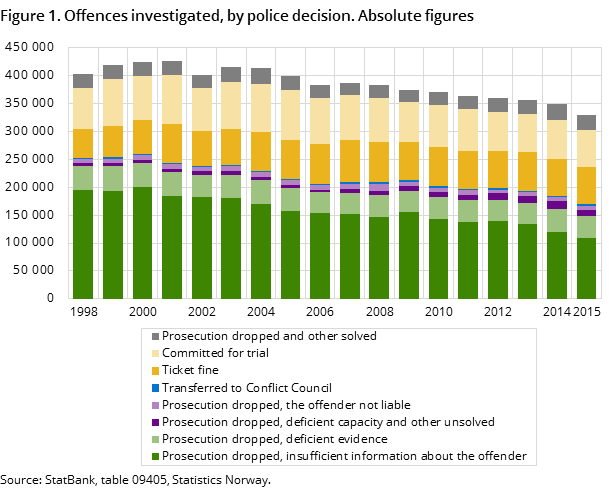
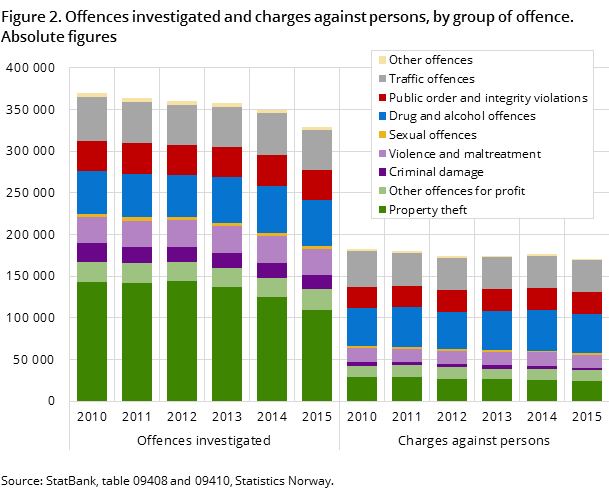
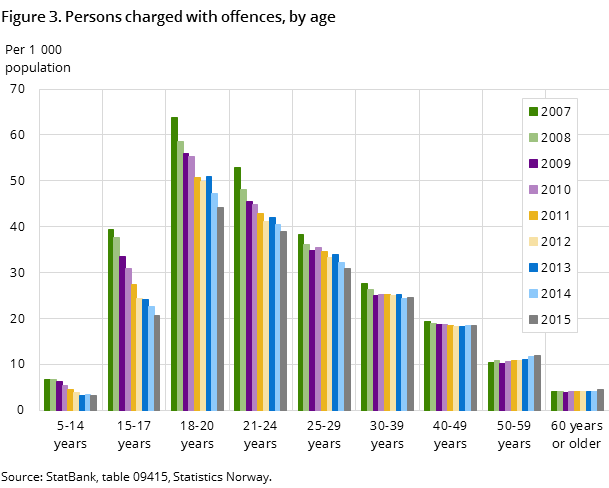
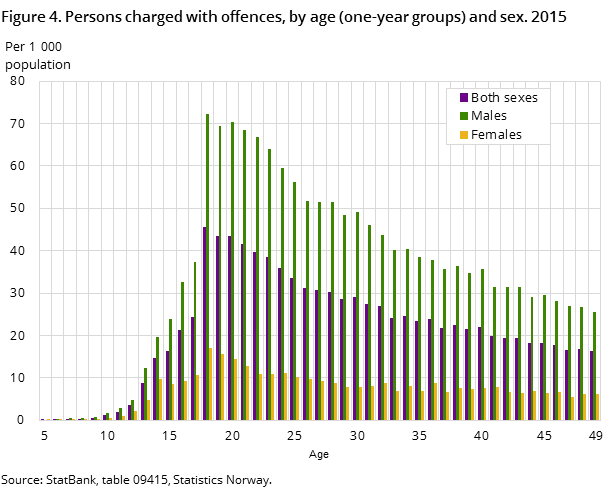
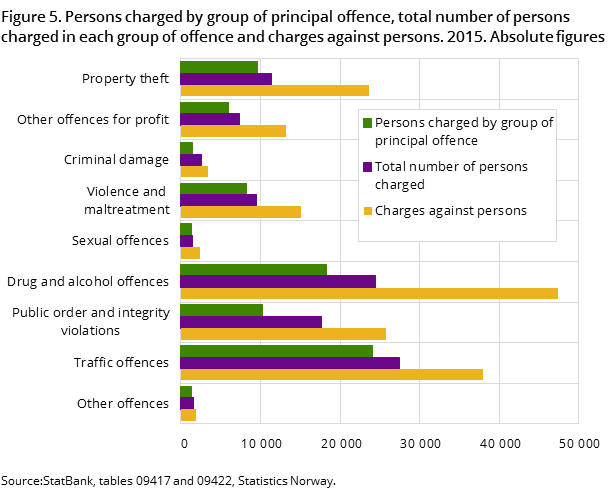
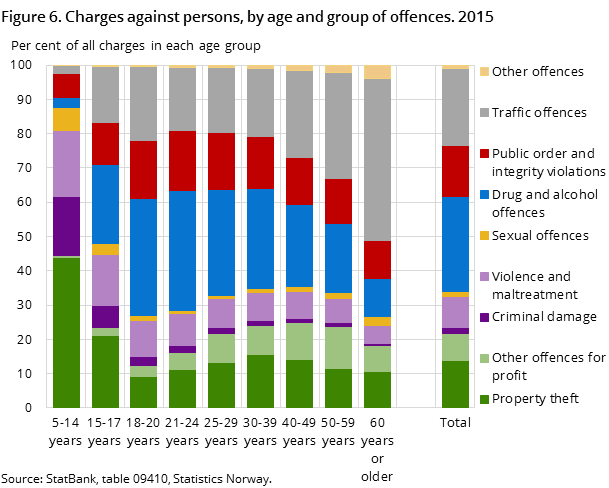
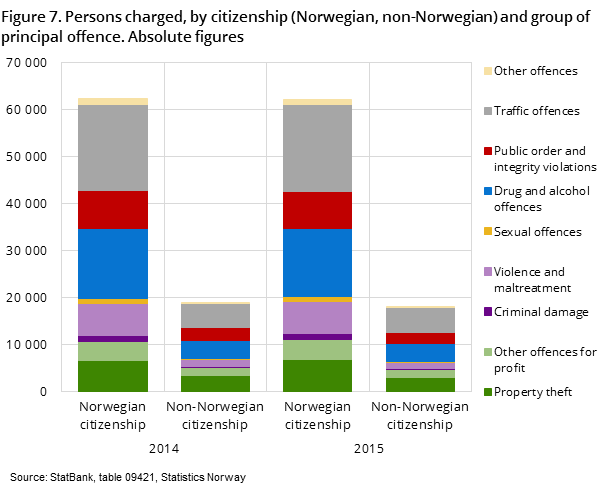
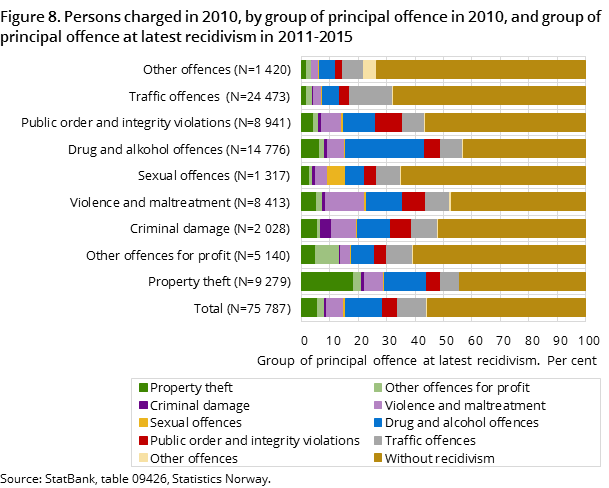
The police and the Prosecution authority completed the investigation of 329 200 offences in 2015. This is 5.8 per cent less than the year before. The number of offences investigated by the police is down by a fifth since the period 2001-2004. This is illustrated in figure 1, which also shows the spread of type of decision given by the police and Prosecution authority in the period 1998-2015.
Biggest drop in thefts investigated
After the new Standard for types of offences was introduced, almost 109 300 property thefts were considered solved in 2015; more than 12 per cent less than the year before and almost 24 per cent fewer than in 2010. The number of offences investigated was also reduced for all of the other groups of offences, except offences that are defined in the new statistics as other offences for profit and sexual offences (see textbox and article about “New crime statistics” (only available in Norwegian)).
Big differences in the clear-up rate for different types of offences
Whether an offence is considered solved or not, and which type of penal decision is given, varies greatly among the different groups and types of offences. Of all groups of offences, drug and alcohol offences have the highest clear-up rate, with 84 per cent in 2015. The clear-up rate is also high for traffic offences and public order and integrity violations in 2015, with 80 and 73 per cent respectively.
Property theft and criminal damage are the groups of offences with the lowest clear-up rate in 2015, with 20 and 19 per cent respectively. The share of solved and unsolved offences varies however for the more specified types of offences in the two groups of offences mentioned. For instance, nearly 78 per cent of all petty thefts from shops and other sales outlets were solved in 2015 compared to just over 2 per cent of all bicycle thefts.
Fewer reported thefts gave a higher total clear-up rate
The difference in the composition of reported and investigated types of offences is vital to understanding the changes in clear-up rates from year to year.
In 2015, 169 100 of all offences investigated were considered solved and 160 100 were considered unsolved. Compared to the year before, this is 3 per cent fewer solved offences and more than 8 per cent fewer unsolved offences. As a result, the total clear-up rate for offences increased from 49.9 per cent in 2014 to 51.4 per cent in 2015. This increase is not due to an increase in the number of offences solved by the police, but rather due to a relatively big reduction in the number of reported thefts – types of offences with an overall low clear-up rate.
Fewer charges and charged persons
In 2015, investigations by the police and Prosecution authority resulted in a total of 170 700 charges against more than 83 300 different persons. The total number of charges is 3 per cent fewer than in 2014, and the decrease is greatest for property theft, drug and alcohol offences and violence and maltreatment. The total number of charged persons is 1 per cent fewer than the year before, but the last year’s changes vary considerably between the groups of offences and between the age groups. The decrease was biggest for drug and alcohol offences, public order and integrity violations and property theft.
Only decrease among those under 30 years of age
Over a long period of time, there has been a large reduction in the number of people charged in the younger age groups, as shown in figure 3. In 2015, a total of 36 700 persons under the age of 30 years were charged with one or more offence, which is nearly 5 per cent fewer than in 2014. When we account for the population growth, the number charged with offences in this age group is reduced by more than 28 per cent during the period 2007-2015.
A continuous low share of persons charged with offences of violence in the youngest age groups in the previous years has contributed to a general decrease in the number of young people charged with offences. A further decrease in the number of young people charged with offences in 2015 compared to 2014 is however due to a reduction among young people charged with other types of offences – for instance theft, narcotic offences and different types of public order and integrity violations.
In 2015, more than 4 600 were charged with theft in total among those under 30 years of age. This is nearly 10 per cent fewer than the previous year, and in absolute numbers the decrease is just as big for both petty theft and the more aggravated thefts. In the age group under 30 years of age, nearly 8 per cent fewer were charged with a public order violation, including breach of the peace under self-induced intoxication, as a principal offence. Furthermore, there were nearly 23 per cent fewer persons charged with document and other violations of integrity in this age group.
30 per cent charged with drug and alcohol offences
In 2015, investigations of more than 54 900 drug and alcohol offences were completed. Of these, 46 000 are regarded as solved. The investigations resulted in 47 300 charges against nearly 24 500 different persons. Of all persons charged with drug and alcohol offences in 2015, 73 per cent had a narcotic offence and 21 per cent had driving under the influence as their principal offence.
Fewer young people charged with narcotic offences
After a historically high number in the two previous years, the more than 13 300 persons in 2015 with a narcotic offence as principal offence was nearly 6 per cent fewer than the previous year. The decrease is approximately the same for the less serious violations of the Act relating to medicines etc. as for the types of offences of narcotics that are classified as a crime under the Penal Code.
Last year`s decline in the number of persons charged with a narcotic offence as their principal offence is mainly for those under 25 years. In total, more than 5 400 persons under 25 years were charged with a narcotic offence in 2015. This is more than 11 per cent fewer than in 2014.
18-20 year-olds still have the highest share of persons charged
Despite the decrease in the last years, young people in the age group 18-20 years are still overrepresented among persons charged with offences, for both sexes. About 7 per cent of all 18 year-old men were charged in 2015. The corresponding share among 18 year-old women was under 2 per cent. As shown in figure 4, men in all ages are far more often charged with offences than women of the same age, and out of all persons charged with offences, 83 per cent were men.
More 50 year-olds charged with driving under the influence
Almost 3 800 persons were charged with driving under the influence as their principal offence in 2015, which is over 9 per cent more than the previous year. The number of persons charged with driving under the influence was equal to the year before, and compared to the previous year the increase was biggest for the age group 50-59 years.
Most persons charged with traffic offences
A total of 27 400 persons were charged with 38 000 charges for traffic offences in 2015. Among the traffic violators, 24 000 also had the traffic offence as their principal offence, while the remaining 3 400 persons were also charged with other types of offences with a higher maximum sentence under the Penal code, as shown in figure 5. Persons charged with traffic offences as their principal offence thus make up 30 per cent of all persons charged with offences in 2015.
9 500 persons charged with violence and maltreatment
In 2015, the police and Prosecution authority completed the investigation of 31 000 offences of violence and maltreatment. Among these, more than 16 200 were considered solved. The investigations led to a total of 9 500 different persons being charged with 15 100 charges for violence and maltreatment.
Out of these charges, 5 950 were for assault, almost 1 300 for bodily harm, nearly 700 for maltreatment in close relations and 1 450 for assault of a public servant. Among the charges for violence and maltreatment, there were also more than 3 300 charges for threats and nearly 1 500 charges for reckless behaviour and stalking.
Prosecution of maltreatment frequently dropped due to deficient evidence
In 2015, the police settled the investigation of 2 400 incidents of maltreatment in close relations, of which more than 650 were considered to be solved. Of the nearly 1 750 unsolved offences, 99 per cent had the prosecution dropped due to deficient evidence. In 2015, the number of completed investigations, charges and charged persons in such cases is somewhat higher than in 2014 – and the highest since the introduction of the Act on ill treatment within family relations in 2006.
Fewer non-Norwegian citizens charged with offences
In 2015, more than 18 100 charged persons held a non-Norwegian citizenship, which is nearly 800 fewer than the year before. Distributed by principal group of offence, 450 fewer persons were charged with property theft and 350 fewer were charged with public order and integrity violations – as shown in figure 7.
Of all non-Norwegians charged, as for Norwegian citizens, 30 per cent were charged with a traffic offence as the principal offence. In 2015, there were more than 5 400 charged non-Norwegians in this group of offence, which is almost 5 per cent more than the year before.
In addition to Norwegians and non-Norwegian citizens registered as residents in Norway, other persons staying in the country for shorter or longer periods of time are registered as offenders. Charged persons with a non-Norwegian place of residence made up less than 8 per cent of all persons charged with offences in 2015 – a smaller share than in the previous two years.
Many charged multiple times, but fewer with recidivism
The statistics on recidivism among the population in Norway show that more than 44 per cent of the 75 800 charged persons in 2010 were charged with at least one new offence during the next five years. This share has gradually dropped in the last eight statistics on recidivism, and the corresponding share in 2002 was nearly 50 per cent.
Distributed by group of principal offence, the highest rate of recidivism is registered among those originally charged with drug and alcohol offences as their principal offence. As shown in figure 8, 57 per cent of the nearly 14 800 persons charged with drug and alcohol offences in 2010 were charged with at least one new offence during the subsequent five-year period. The corresponding share among those originally charged with property theft and violence and maltreatment was almost as high. In these groups, 56 and 53 per respectively were charged with recidivism. Of all persons charged with a sexual offence as their principal offence in 2010, recidivism is registered for 35 per cent during the years 2011-2015.
Recidivism rate still highest among men
The last statistics on recidivism show that the recidivism rate among men is almost 48 per cent, while the corresponding female recidivism rate is 30 per cent. The share of men with recidivism is still decreasing with higher age, while there are far fewer disparities among the different female age groups.
As in earlier years, the main age for recidivism among men is 15-17 years, and almost 64 per cent of the 4 600 young men charged in 2010 were registered with recidivism during the years 2011-2015. The corresponding age group for women is 30-39 years.
New statistics with new classification of offences 2002-2015Open and readClose
Statistics Norway now releases statistics by new Standard for types of offence. Types of offence 2015 is made as a consequence of the penal code of 2005, together with new police codes for registering offences, came into effect on 1 October 2015.The standard includes new groupings of both Type of offence and Group of offence, while Category of offences (crime and misdemeanour) is not continued. New classification of offences is made available for certain tables in StatBank with figures back to 2002. Group of offence 2015 and Type of offence 2015 are included in the existing tables. A detailed overview, including relation to the police codes for offences, is now available in Statistical Classifications and Code Lists.
Contact
-
Reid Jone Stene
E-mail: reid.jone.stene@ssb.no
tel.: (+47) 99 02 22 01
-
Siri Fjærtoft Fossanger
E-mail: siri.fossanger@ssb.no
tel.: (+47) 99 72 49 27
-
Sigmund Book Mohn
E-mail: sigmund.mohn@ssb.no
tel.: (+47) 94 32 77 22
